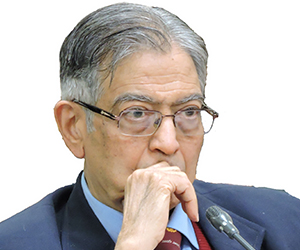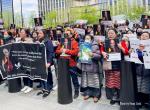US President Barack Obama's three day visit to India from January 25th to 27th as the chief guest for our Republic Day celebrations has been appropriately termed by our Foreign Secretary as "historic" and has resulted in the "qualitative reinvigoration" of India-US ties and a deepening of their strategic partnership. Not only has it been high on symbolism but it has also had "significant and substantive" outcomes in many areas notably strategic, civil nuclear, defence, security, energy and economic as evident from the Joint Statement, the Joint Strategic Vision Statement on Asia Pacific and the Indian Ocean Region, and the Delhi Declaration of Friendship issued on January 25th 2015.
The symbolism of the visit stems from the fact that President Obama is the first US President not only to have come to India twice, whilst holding that office, but also to have been the chief guest at our Republic Day. The growing India-US proximity was even more graphically demonstrated by the Prime Minister personally receiving the President at the airport, over and beyond the requirements of protocol, by indicators that the two leaders were not only comfortable in interacting with each other on a one on one basis but actually enjoyed doing so, by the decision to hold regular summits with increased periodicity, by the issuance of a Declaration of Friendship and finally by the decision to establish a hotline between them--a first for India-- as well as their NSA's.
The US-India joint strategic vision for Asia Pacific and the Indian Ocean Region, clearly triggered by China's hegemonistic tendencies, symbolises the intent of the two countries, as never before, in partnering together to shape the region along with other Asian players. It specifically envisages that from Africa to East Asia, India and USA would "support sustainable, inclusive development, and increased regional connectivity by collaborating with other interested partners to address poverty and support broad-based prosperity" and that they would also work together to "promote accelerated infrastructure connectivity and economic development in a manner that links South, Southeast and Central Asia, including by enhancing energy transmission and encouraging free trade and greater people-to-people linkages." This constitutes a potent counter to China's increasing penetration of the region including through promotion of ideas like the maritime silk route. The strategic vision document goes on to reiterate the thinly disguised China specific points made in the India-US joint statement of September 2014 on the " importance of safeguarding maritime security and ensuring freedom of navigation and over flight throughout the region, especially in the South China Sea" and calls "on all parties to avoid the threat or use of force and pursue resolution of territorial and maritime disputes through all peaceful means, in accordance with universally recognized principles of international law, including the United Nations Convention on the Law of the Sea." It furthermore commits both countries to developing a roadmap for achieving this vision by leveraging their efforts to increase ties among Asian powers which would enable India and the US to better respond to diplomatic, economic and security challenges in the region. It also reflects US support to India's quest for membership of APEC.
The resolution of the six year long logjam on India-US civil nuclear cooperation which had soured relations between the two countries can only be welcomed and will bolster an upturn in ties. This has been achieved through a process of give and take and the Modi government needs to be commended for having been able to do so in such a short time. The US has given up on its earlier insistence on undertaking end use etc inspections mandated by the Hyde Act and will be satisfied with the IAEA monitoring which we had to submit to under the 123 Agreement. It is understood that the outcome of such monitoring will be made available to the US. India, on its part, has created an insurance pool part financed by public sector insurance companies and part financed by the government to take care of operator/supplier liabilities. With both countries satisfied on monitoring and liability, the major hurdle to the operationalisation of civil nuclear cooperation between them has been overcome and it is now upto US firms to take matters further. Having said this, it may be noted that one has never been a supporter of the nuclear deal as concluded by the UPA government as the costs involved for the new imported reactors are exorbitant, the technology untested, and the quid pro quo including inter alia the mothballing of the Cirus reactor, IAEA monitoring etc much too onerous. India would have done much better by not having concluded the nuclear deal in the first place and having gone ahead with building the much cheaper heavy water nuclear reactors the technology of which is proven and which we have mastered.
One of the more important outcomes of the visit was in the area defence and security. The renewal of the Defence Framework Agreement for a further period of ten years coupled with the identification of four projects for joint development and production under the Defence Technology and Trade Initiative are indicators that defence cooperation between the two countries is set to be taken to a higher level. Indeed, it is understood that a working group has also been established to explore aircraft carrier technology sharing and design, and development of jet engine technology. Clearly, India's inhibitions for military dealings with the US have been set aside and the two countries are now well poised for enhanced military cooperation which will not be merely restricted to exercises and purchases but will also entail a transfer of technology as well as co development and co production.
India's core concerns on terrorism were addressed more comprehensively in the joint statement than perhaps ever before. It devoted three paragraphs to the issue as against two in the September 2014 joint statement. Apart from calling on Pakistan to bring to justice the perpetrators of the Mumbai attacks and reaffirming the need for "joint and concerted efforts to disrupt entities" like LeT, JeM, D Company and the Haqqani network, it committed the two leaders" to undertake efforts to make the U.S-India partnership a defining counterterrorism relationship for the 21st Century by deepening collaboration to combat the full spectrum of terrorist threats and keep their respective homelands and citizens safe from attacks....." and "to continue to work toward an agreement to share information on known and suspected terrorists." Thus, India-US operational collaboration in addressing terrorism is set to achieve a new high.
Clean energy was another issue of intense focus. As signalled by the Foreign Secretary, the two countries agreed to expand their partnership on clean energy research, development, manufacturing and deployment and President Obama expressed interest in participating in India’s ambitious 100 GW solar energy programme. During his interaction with CEOs on 27th January, Obama announced that the USTDA would leverage $2billion for investment in renewable energy in India. The joint statement reveals that negotiations have been concluded on a five year India-US MOU on energy security, clean energy and climate change to carry forward work in these areas.
Economic and commercial cooperation were central to the visit and permeated the entire interaction. Defence, nuclear and energy cooperation obviously have commercial ramifications and there is little doubt that with India determined to create a more business friendly environment, economic cooperation is set to increase dramatically. In order to give a further push to economic and commercial cooperation, both sides are to resume discussions on a high standard bilateral investment treaty and a totalisation agreement. Three MoUs have been signed between the USTDA and the State Governments of Andhra Pradesh, Rajasthan and Uttar Pradesh to support the development of smart cities in Visakhapatnam, Allahabad and Ajmer. India and the US are also to collaborate on the Digital India Programme. President Obama also promised to support the enhancement of "India's voice and vote in International Financial Institutions and ensuring that resources are made available and used creatively through multilateral development banks for infrastructure financing." Finally, the decision to elevate the India-US strategic dialogue to a strategic and commercial dialogue reflects the commitment of the two countries to place an even greater focus on commercial and economic ties.
It would be safe to conclude from the foregoing that Obama's India visit was an unqualified success. It marks an important step in transforming the long stagnating India-US ties into a vibrant, multi dimensional and mutually supportive relationship. Full credit for this must go to the Modi government for being able to do so within a few months of assuming office. Critics of the government have chosen to try and take the sheen off the visit by suggesting that Obama had extended a warning to the Modi government during his address at the Siri Fort auditorium on the imperatives of maintaining freedom of religion. Such a suggestion is unfounded as Obama in his wide ranging address was merely referring to the truism of the need to respect freedom of religion the world over, including particularly in pluralistic countries like USA and India, which is readily accepted by many governments including ours. Accordingly, this negative line of argumentation by critics of the government is not only inaccurate but also churlish.
Published Date: 29th January 2015, Image source: http://www.ndtv.com
(Disclaimer: The views and opinions expressed in this article are those of the author and do not necessarily reflect the official policy or position of the Vivekananda International Foundation)










Post new comment